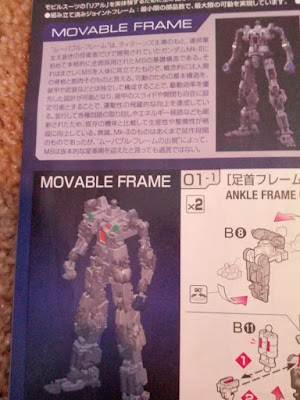The Real Grade line of model kits is unified by a common theme - to offer the detail and complexity of Master and Perfect Grade kits in a model the size of a High Grade. One way in which it achieves this is through its use of the “Advanced MS Joint” system. Each kit is built on top of a highly flexible, very pose-able internal frame. The individual pieces of the frame are incredibly complex; they can bend and twist on their own, right out of the box. All the builder has to do is snap them together (to be fair, it can get a little tricky, but on a whole most of the work is already done for you). Indeed, one of Bandai’s favorite promotional images for the line shows how you can build the entire frame on its own before attaching any armor or accessories.
That being said, the instruction booklets for both the Zaku and OG Gundam still have you build each part one by one, attaching them together at the end to get a finished mobile suit. I assumed this would still be the case with the Mk. II, but in a surprising twist the build has been changed to something which more closely mimics the promotional pics. If you were to follow the instructions step by step, you would end up building the entire frame to completion, then attaching the armor.
There are several possibilities to explain what happened here. One is that Bandai simply bought into their own marketing. Another is that it was born out of necessity (though I don’t see any evidence that this is the case). A third option - and the one which I want to be true - is that the kit is trying to simulate the process of building a mobile suit which uses a Moveable Frame (which I discussed in the intermission).
As evidence, I will point out that the instructions actually contain the term “Moveable Frame”, whereas the booklets for my previous two models do not.

If I’m right about this one, then I hope to one day shake the hand of someone at Bandai who is responsible for designing Real Grade kits, because holy crap.
The Mk. II adds an additional twist to the build process, in the form of mesh tubing. I’ve already used most of it, but here’s a picture of what’s left.

The tubing is used on the model’s legs and backpack; I assume it simulates cabling of some sort. The instructions provide small rulers to let you know how long to cut each piece. Out of curiosity, I compared what tubing I had left to the ruler used for the backpack section, and learned that the kit gives you exactly the right amount of tubing and no more. There is zero margin for error here, which is kind of scary.
A few more general observations about the body:
Based on the instructions, the completed frame for the Mk. II looks a lot more detailed than Zaku’s or Gundam’s. This makes sense when you consider that in the universe of the TV shows, those two suits were not actually built on an internal frame. However the kit can’t really get away with being frameless, so the one they use is as simple looking as possible, while still being every bit as functional.
At the time of writing, I’ve only finished assembling the legs, but from what I can tell the frame is much more visible than compared to the previous two suits. The armor is also a lot easier to attach and remove. This is again in line with the descriptions of how Moveable Frame-style mobile suits were designed. I don’t believe it is coincidence.
The pieces which make up the Mk. II’s advanced frame are different than the other two (which I believe were identical). Not only do their appearances differ, but so far I have not been asked to take apart a frame piece and reassemble it later. In other words, it is easier to work with, and much less prone to error.
Next post will go over the legs and wait in detail. Until then, here’s a sneak peek.
